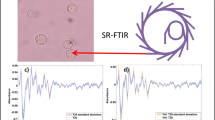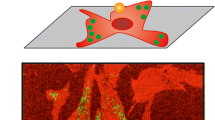Abstract
Fourier transform infrared (FTIR) microspectroscopy provides a biochemical fingerprint of the cells. In this study, chemical changes in 143B osteosarcoma cells were investigated using FTIR analysis of cancer cells after their treatment with polymeric invertible micellar assemblies (IMAs) and curcumin-loaded IMAs and compared with untreated osteosarcoma cells. A comprehensive principal component analysis (PCA) was applied to analyze the FTIR results and confirm noticeable changes in cell surface chemical structures in the fingerprint regions of 1480–900 cm−1. The performed clustering shows visible differences for all investigated groups of cancer cells. It is demonstrated that a combination of FTIR microspectroscopy with PCA can be an efficient approach in determining interactions of osteosarcoma cells and drug-loaded polymer micellar assemblies.








Similar content being viewed by others
Data availability
All data supporting the findings of this study are available within the article.
References
Harrison DJ, Geller DS, Gill JD, Lewis VO, Gorlick R. Current and future therapeutic approaches for osteosarcoma. Expert Rev Anticanc. 2018;18(1):39–50. https://doi.org/10.1080/14737140.2018.1413939.
Arndt CAS, Rose PS, Folpe AL, Laack NN. Common musculoskeletal tumors of childhood and adolescence. Mayo Clin Proc. 2012;87(5):475–87. https://doi.org/10.1016/j.mayocp.2012.01.015.
Talari ACS, Martinez MAG, Movasaghi Z, Rehman S, Rehman IU. Advances in Fourier transform infrared (FTIR) spectroscopy of biological tissues. Appl Spectrosc Rev. 2017;52(5):456–506. https://doi.org/10.1080/05704928.2016.1230863.
Bellisola G, Sorio C. Infrared spectroscopy and microscopy in cancer research and diagnosis. Am J Cancer Res. 2012;2(1):1–21.
Diem M, Romeo M, Boydston-White S, Miljkovic M, Matthaus C. A decade of vibrational micro-spectroscopy of human cells and tissue (1994-2004). Analyst. 2004;129(10):880–5. https://doi.org/10.1039/b408952a.
Baker MJ, Trevisan J, Bassan P, Bhargava R, Butler HJ, Dorling KM, et al. Using Fourier transform IR spectroscopy to analyze biological materials. Nat Protoc. 2014;9(8):1771–91. https://doi.org/10.1038/nprot.2014.110.
De Bruyne S, Speeckaert MM, Delanghe JR. Applications of mid-infrared spectroscopy in the clinical laboratory setting. Crit Rev Clin Lab Sci. 2018;55(1):1–20. https://doi.org/10.1080/10408363.2017.1414142.
Gajjar K, Heppenstall LD, Pang WY, Ashton KM, Trevisan J, Patel II, et al. Diagnostic segregation of human brain tumours using Fourier-transform infrared and/or Raman spectroscopy coupled with discriminant analysis. Anal Methods-Uk. 2013;5(1):89–102. https://doi.org/10.1039/c2ay25544h.
Gajjar K, Trevisan J, Owens G, Keating PJ, Wood NJ, Stringfellow HF, et al. Fourier-transform infrared spectroscopy coupled with a classification machine for the analysis of blood plasma or serum: a novel diagnostic approach for ovarian cancer. Analyst. 2013;138(14):3917–26. https://doi.org/10.1039/c3an36654e.
Sheng DP, Xu FC, Yu Q, Fang TT, Xia JJ, Li SR, et al. A study of structural differences between liver cancer cells and normal liver cells using FTIR spectroscopy. J Mol Struct. 2015;1099:18–23. https://doi.org/10.1016/j.molstruc.2015.05.054.
Mehrotra R, Tyagi G, Charak S, Ray B, Kadayaprath G, Chaturvedi H, et al. Biospectroscopic analysis of human breast cancer tissue: probing infrared signatures to comprehend biochemical alterations. J Biomol Struct Dyn. 2018;36(3):761–6. https://doi.org/10.1080/07391102.2017.1298469.
Ma YL, Zhang P, Yang YZ, Wang F, Qin HL. Metabolomics in the fields of oncology: a review of recent research. Mol Biol Rep. 2012;39(7):7505–11. https://doi.org/10.1007/s11033-012-1584-1.
Bunaciu AA, Hoang VD, Aboul-Enein HY. Applications of FT-IR spectrophotometry in cancer diagnostics. Crit Rev Anal Chem. 2015;45(2):156–65. https://doi.org/10.1080/10408347.2014.904733.
Old OJ, Fullwood LM, Scott R, Lloyd GR, Almond LM, Shepherd NA, et al. Vibrational spectroscopy for cancer diagnostics. Anal Methods-Uk. 2014;6(12):3901–17. https://doi.org/10.1039/c3ay42235f.
Bhargava R, Wall BG, Koenig JL. Comparison of the FT-IR mapping and imaging techniques applied to polymeric systems. Appl Spectrosc. 2000;54(4):470–9. https://doi.org/10.1366/0003702001949870.
Tabachnick BG, Fidell LS. Using multivariate statistics. 6th ed. Boston: Pearson Education; 2013.
Fjodorova N, Novic M, Venko K, Rasulev B. A comprehensive cheminformatics analysis of structural features affecting the binding activity of fullerene derivatives. Nanomaterials (Basel). 2020;10:1. https://doi.org/10.3390/nano10010090.
Pham-The H, Cabrera-Perez MA, Nam NH, Castillo-Garit JA, Rasulev B, Le-Thi-Thu H, et al. In silico assessment of ADME properties: advances in Caco-2 cell monolayer permeability modeling. Curr Top Med Chem. 2018;18(26):2209–29. https://doi.org/10.2174/1568026619666181130140350.
Rasulev B. Recent developments in 3D QSAR and molecular docking studies of organic and nanostructures. Handbook of Computational Chemistry. p. 2133–61. https://doi.org/10.1007/978-3-319-27282-5_54.
Hevus I, Modgil A, Daniels J, Kohut A, Sun CW, Stafslien S, et al. Invertible micellar polymer assemblies for delivery of poorly water-soluble drugs. Biomacromolecules. 2012;13(8):2537–45. https://doi.org/10.1021/bm3007924.
Maran A, Yaszemski MJ, Kohut A, Voronov A. Curcumin and osteosarcoma: can invertible polymeric micelles help? Materials. 2016;9:7. https://doi.org/10.3390/ma9070520.
Hevus I, Voronov A, Yaszemski MJ, Maran A, Kohut A, Voronov S. Chapter 14 - Anticancer efficiency of curcumin-loaded invertible polymer micellar nanoassemblies. In: Ficai A, Grumezescu AM, editors. Nanostructures for cancer therapy. Amsterdam: Elsevier; 2017. p. 351–82.
Kudina O, Shogren KL, Gustafson CT, Yaszemski MJ, Maran A, Voronov A. Invertible micellar polymer nanoassemblies target bone tumor cells but not normal osteoblast cells. Futur Sci Oa. 2015;1:3. https://doi.org/10.4155/fso.15.14.
Ramadurai S, Kohut A, Sarangi NK, Zholobko O, Baulin VA, Voronov A, et al. Macromolecular inversion-driven polymer insertion into model lipid bilayer membranes. J Colloid Interface Sci. 2019;542:483–94. https://doi.org/10.1016/j.jcis.2019.01.093.
Machana S, Weerapreeyakul N, Barusrux S, Thumanu K, Tanthanuch W. FTIR microspectroscopy discriminates anticancer action on human leukemic cells by extracts of Pinus kesiya; Cratoxylum formosum ssp pruniflorum and melphalan. Talanta. 2012;93:371–82. https://doi.org/10.1016/j.talanta.2012.02.058.
Srisayam M, Weerapreeyakul N, Barusrux S, Tanthanuch W, Thumanu K. Application of FTIR microspectroscopy for characterization of biomolecular changes in human melanoma cells treated by sesamol and kojic acid. J Dermatol Sci. 2014;73(3):241–50. https://doi.org/10.1016/j.jdermsci.2013.11.002.
Bassan P, Kohler A, Martens H, Lee J, Byrne HJ, Dumas P, et al. Resonant Mie scattering (RMieS) correction of infrared spectra from highly scattering biological samples. Analyst. 2010;135(2):268–77. https://doi.org/10.1039/b921056c.
Antonietti M. Nanostructured materials - self-organization of functional polymers. Nat Mater. 2003;2(1):9–10. https://doi.org/10.1038/nmat791.
Walsh MJ, German MJ, Singh M, Pollock HM, Hammiche A, Kyrgiou M, et al. IR microspectroscopy: potential applications in cervical cancer screening. Cancer Lett. 2007;246(1–2):1–11. https://doi.org/10.1016/j.canlet.2006.03.019.
Grzelak MM, Wrobel PM, Lankosz M, Stegowski Z, Chmura L, Adamek D, et al. Diagnosis of ovarian tumour tissues by SR-FTIR spectroscopy: a pilot study. Spectrochim Acta A. 2018;203:48–55. https://doi.org/10.1016/j.saa.2018.05.070.
Bassan P, Byrne HJ, Bonnier F, Lee J, Dumas P, Gardner P. Resonant Mie scattering in infrared spectroscopy of biological materials - understanding the ‘dispersion artefact’. Analyst. 2009;134(8):1586–93. https://doi.org/10.1039/b904808a.
Kar S, Katti DR, Katti KS. Fourier transform infrared spectroscopy based spectral biomarkers of metastasized breast cancer progression. Spectrochimica Acta Part A: Molecular and Biomolecular Spectroscopy. 2019;208:85–96. https://doi.org/10.1016/j.saa.2018.09.052.
Steller W, Einenkel J, Horn L-C, Braumann U-D, Binder H, Salzer R et al. Delimitation of squamous cell cervical carcinoma using infrared microspectroscopic imaging. Analytical and Bioanalytical Chemistry. 2006;384(1):145–54. https://doi.org/10.1007/s00216-005-0124-4.
Lipiec E, Bambery KR, Lekki J, Tobin MJ, Vogel C, Whelan DR et al. SR-FTIR Coupled with Principal Component Analysis Shows Evidence for the Cellular Bystander Effect. Radiation Research. 2015;184(1):73–82. https://doi.org/10.1667/RR13798.1.
Ozek NS, Tuna S, Erson-Bensan AE, Severcan F. Characterization of microRNA-125b expression in MCF7 breast cancer cells by ATR-FTIR spectroscopy. Analyst. 2010;135(12):3094–102. https://doi.org/10.1039/c0an00543f.
Flower KR, Khalifa I, Bassan P, Demoulin D, Jackson E, Lockyer NP et al. Synchrotron FTIR analysis of drug treated ovarian A2780 cells: an ability to differentiate cell response to different drugs? Analyst. 2011;136(3):498–507. https://doi.org/10.1039/c0an00564a.
Romeo M, Mohlenhoff B, Diem M. Infrared micro-spectroscopy of human cells: Causes for the spectral variance of oral mucosa (buccal) cells. Vib Spectrosc. 2006;42(1):9–14. https://doi.org/10.1016/j.vibspec.2006.04.009.
Boydston-White S, Romeo M, Chernenko T, Regina A, Miljkovic M, Diem M. Cell-cycle-dependent variations in FTIR micro-spectra of single proliferating HeLa cells: principal component and artificial neural network analysis. Biochim Biophys Acta. 2006;1758(7):908–14. https://doi.org/10.1016/j.bbamem.2006.04.018.
Lee DS, Lee MK, Kim JH. Curcumin induces cell cycle arrest and apoptosis in human osteosarcoma (HOS) cells. Anticancer Res. 2009;29(12):5039–44.
Karunagaran D, Rashmi R, Kumar TR. Induction of apoptosis by curcumin and its implications for cancer therapy. Curr Cancer Drug Targets. 2005;5(2):117–29. https://doi.org/10.2174/1568009053202081.
Al-Jorani K, Rüther A, Haputhanthri R, Deacon GB, Li HL, Cullinane C, et al. ATR-FTIR spectroscopy shows changes in ovarian cancer cells after incubation with novel organoamidoplatinum(ii) complexes. Analyst. 2018;143(24):6087–94. https://doi.org/10.1039/C8AN01558A.
Giorgini E, Sabbatini S, Rocchetti R, Notarstefano V, Rubini C, Conti C, et al. In vitro FTIR microspectroscopy analysis of primary oral squamous carcinoma cells treated with cisplatin and 5-fluorouracil: a new spectroscopic approach for studying the drug–cell interaction. Analyst. 2018;143(14):3317–26. https://doi.org/10.1039/C8AN00602D.
Funding
This study was funded by Mayo Clinic.
Author information
Authors and Affiliations
Corresponding author
Ethics declarations
Conflict of interest
The authors declare that they have no conflict of interest.
Additional information
Publisher’s note
Springer Nature remains neutral with regard to jurisdictional claims in published maps and institutional affiliations.
Electronic supplementary material
ESM 1
(PDF 972 kb)
Rights and permissions
About this article
Cite this article
Serdiuk, V., Shogren, K.L., Kovalenko, T. et al. Detection of macromolecular inversion–induced structural changes in osteosarcoma cells by FTIR microspectroscopy. Anal Bioanal Chem 412, 7253–7262 (2020). https://doi.org/10.1007/s00216-020-02858-4
Received:
Revised:
Accepted:
Published:
Issue Date:
DOI: https://doi.org/10.1007/s00216-020-02858-4




